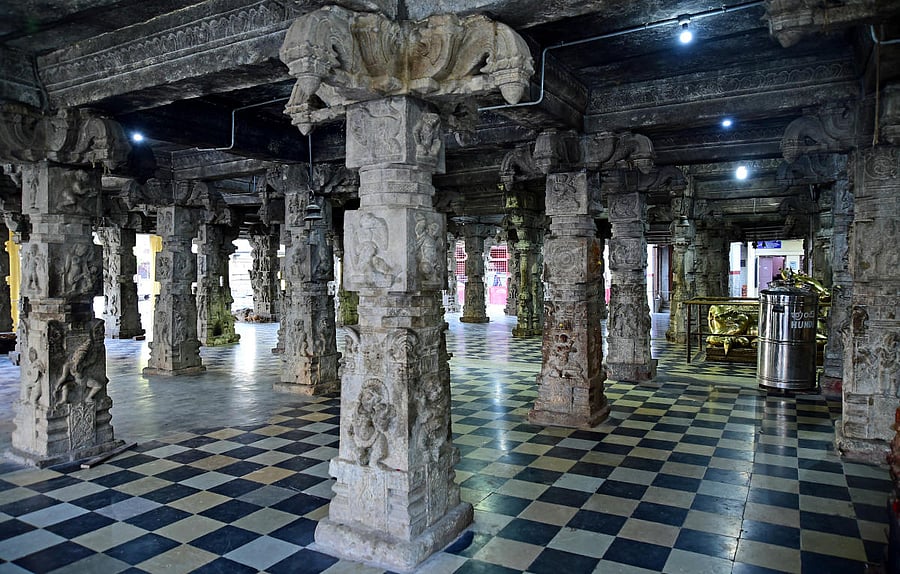

The Someshwara temple in Ulsoor, just a stone’s throw from Bengaluru’s central business district, is one of the city’s oldest and most beautiful temples.
The temple has no foundational inscriptions, but based on architectural styles and context, scholars believe the main temple’s core dates back to about a millennium.
However, the grand mandapa and the huge entrance are likely from the 16th century, while the shrine dedicated to Goddess Kamakshi was probably built in the 1700s.
The temple’s pillars and walls are rich with sculpture, all in a style strongly reminiscent of Hampi. A dramatic rendering of Ravana shaking Mt Kailash, the story of Bedara Kannappa, an anthropomorphic Gandabherunda (the double-headed eagle), the ever-faithful devotee Vyaghrapada are all here, besides of course, a plethora of dancers, cavorting monkeys, saints, ascetics, horse riders, and so on.
While such figures are common to many temples, a depiction that is unique to this temple is the set of carvings of the Nava Nathas — nine Shaiva saints, who are usually shown seated on different wild animals — shown here in a row along the temple’s southern wall. Historian Anila Verghese describes the animal mounts as a fish, bear, tiger, snake, scorpion, tortoise, makara, antelope and boar.
Nava Nathas
The most popular and well-known of the Nava Nathas are Matsyendranath and his disciple Gorakshanath, who is also said to be the founder of hatha yoga. Carvings of Matsyendranath seated on his fish grace the pillars and walls of many south Indian temples, but according to Verghese, Someshwara temple’s depiction of all nine Nathas is very rare.
Another interesting frieze is the Girija Kalyana story — the marriage of Shiva and Parvati — on the outer walls of the Kamakshi shrine. This is a popular story, especially in temples around Bengaluru. The narration begins on the southern wall with Vishnu, Brahma and the bridegroom, Shiva, all shown setting out for the wedding. Then follow carvings of saptarishis, ascetics, the guardians of the eight directions, and other divinities.
Then comes the marriage ceremony, with Brahma officiating as the priest, while Parvati’s father Himavan gives the bride away. And at the end of the sequence, Shiva is once again shown astride Nandi, this time accompanied by his new wife, Goddess Parvati.
There is another important, little-known facet to this temple’s hoary history.
In 1908, the very year that 15,000 women first marched for better pay and voting rights in far-away New York, a woman named Venkata Sundara Sani published a book — no mean feat in those days — on the performing arts.
Sani was a devadasi attached to the Someshwara temple.
Dance has long been an inherent part of temple worship and musicians and dancers have been attached to temples since at least the 10th century. Beginning in the late 1800s, the devadasi system came under vociferous attack from social reform movements.
Newspapers and speakers around the country derided the ‘immorality’ of the system and its ‘fallen women’. In 1909, the Mysore administration discontinued the services of devadasis in all Muzrai temples in the State. In the Madras Presidency, the fiery Muthulakshmi Reddy campaigned for abolishing the system.
Discussions of devadasi history in Bengaluru usually focus on Bangalore Nagarathnamma and her musical contributions. But of the hundreds of dancers associated with temples around Bengaluru and Kolar, we hear very little.
Performing arts
Gayathri Iyer, a Bengaluru-based dancer, and a dance and art historian, says, “In the 19th and early 20th centuries, the Bengaluru region had a thriving temple culture, with an emphasis on performing arts. While Mysore served as a seat of artistic production and performative showcase, this region’s pivotal contributions to dance and music through temple traditions are often overlooked.” It is in this context that Venkata Sundara Sani’s voice becomes extremely important.
The Rasikajana Manollasini is in Sanskrit, written using the Kannada script. “It has chapters on drama, dance, music and poetry, with principles drawn from the Natyashastra, Kavya Shastras (poetic prescriptive texts) and several treatises on music,” explains Gayathri.
What motivated Venkata Sundara Sani’s courageous decision to publish her book in the midst of the social ferment of the time? Was she trying to show the world that her dance was an art form rooted in classical traditions?
Last month, after three years of research, Gayathri staged a performance that featured some dances based on Venkata Sundara Sani’s book, and were likely performed at the Someshwara temple: a dance to propitiate the guardians of the directions, one to welcome the Lord back after the chariot festival, another to end the day, and so on.
The devadasis of this region are lost to history but thanks to Venkata Sundara Sani’s book, their dance lives on.
(The writer is the author of ‘Discovering Bengaluru’ and the Convenor of INTACH Bengaluru Chapter)